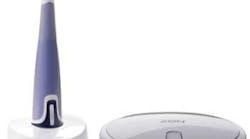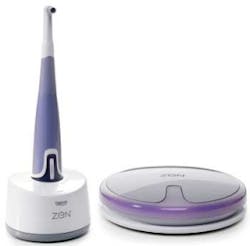Handpiece provides ergonomic, portability benefits
by Maria Perno Goldie, RDH, MS
Dental hygienists are prone to work-related injuries, so the implementation of sound ergonomic principles is imperative to remain healthy. Safe lifting techniques, proper posture, appropriate seating position, and adaptive equipment are examples of ergonomics in the workplace. A literature review suggests that the prevalence of general musculoskeletal pain ranges between 64% and 93%. The most prevalent regions for pain in dental hygienists have been shown to be the hand and wrist regions (60% to 69.5%).1
Being aware of good work practices can decrease work-related injuries, increase operator comfort, improve health and quality of life, and lengthen the number of years we are able to practice.
Dental hygienists can decrease work-related injuries by learning proper positioning of themselves and their patients, using equipment that is ergonomically “friendly,” and designing the chair, unit, handpieces, instruments, and other “tools of the trade” to decrease strain. The wrists, back, neck, and muscles have boundaries regarding extension, twisting, flexion, and tension. Fatigue, discomfort, pain, absences from work, and less productivity are some of the consequences of poor ergonomics.
The World Health Organization (WHO) defines a musculoskeletal disorder as: “a disorder of the muscles, tendons, peripheral nerves, or vascular system not directly resulting from an acute trauma or instantaneous event.”2 These disorders can occur from cumulative traumas and prolonged static postures. Repetitive movements — such as scaling, polishing, root planing, and vibrations from handpieces and powered instruments — can all cause problems if not used correctly.
So how do we protect ourselves? By being aware of our workstation layout, accessibility and diameter3 of instruments, correct position of hoses, and use of cordless handpieces such as the Zen unit.
The Zen Cordless Handpiece has total maneuverability, eliminates “cord-catching,” and causes less stress and user fatigue. The wireless connection between the foot pedal and the handpiece enhances portability, allows flexibility for movement, enables movement from operatory to operatory without limitations, and improves control of speed and power with a rheostat foot pedal.
The Zen unit was field tested by dental hygienists across the country.
Betsy Reynolds, RDH, MS, speaker, author, and practicing dental hygienist, reports: “Love the idea of a cordless handpiece! Primarily because it will decrease cord drag for increased ergonomics — practitioners already hampered by carpel tunnel or other compromising conditions will be over the moon to learn of this option. Secondly, the cordless handpiece will provide portability and open up opportunities for public health programs in settings that do not have formal operatories with handpiece hook-ups.”
Some dental hygienists work in facilities where portable equipment is necessary, such as nursing homes and hospitals. Ann Eshenaur Spolarich, RDH, PhD, speaker, author, and clinician, states: “The portability makes this handpiece easier for me to treat my patients who are wheelchair-bound. Working in an office with seniors I found it so much safer to be able to lift the cordless foot pedal out of the way.”
The Zen unit comes with an autoclavable shell that simply slips over the handpiece. It ensures the highest level of infection control between each appointment, and provides a firm, non-slip grip for better handling, greater performance, and reduced waste. By being “green,” your practice becomes more attractive to the growing number of dental patients who want to reduce their carbon footprint by using eco-friendly goods and services.
Betsy states, “The autoclavable shell contributes to the ergonomics of the handpiece (minimal slippage when compared to a bulky plastic barrier sleeve) and is greener — no disposable, non-biodegradable barrier to deal with.”
The ergonomic design provides a lightweight and balanced handpiece that reduces clinician fatigue and wrist strain, and has a full 360-degree swivel with no cord drag. The cordless handpiece has a high powered lithium rechargeable battery that allows for extended use. The discrete compact charger base is designed for counter or wall mount.
Rebecca Wilder, BSDH, MS, and professor at University of North Carolina-Chapel Hill, states: “The Zen prophy angle was lightweight, easy to maneuver, and very effective at polishing the enamel surfaces. The transportability features will make it very useful for clinicians to use in various practice settings, from traditional dental offices to nursing homes, mission trips, and other health-care facilities.”
The Zen unit allows a choice of latex-free disposable angles that are available in soft and firm, snap easily and securely onto the handpiece, and are designed for durability and smoother performance for significantly reduced splatter. It’s important to note that in some people — patients and clinicians alike — exposure to latex may result in skin rashes, hives, flushing, itching, nasal, eye, or sinus symptoms, asthma, and (rarely) shock.4
JoAnn R. Gurenlian, RDH, PhD, president of Gurenlian & Associates, works in a medical office as well as performs clinical dental hygiene. JoAnn noted: “I was very impressed with how easy it was to maneuver the handpiece in hard-to-reach areas of the mouth without feeling the tug of the cord providing resistance. The handpiece is light in weight and my hand did not experience fatigue during the course of the day.”
I tested the Zen unit also. Lack of operator fatigue and easy maneuverability were the attributes I particularly enjoyed. Experts urge creating a calm and simple productivity with a Zen-like working environment. By doing so, we can better focus and lower our level of stress. The plan is to make our work environment soothing, productive, and peaceful, and to make the principle of ergonomics work for us. Avoiding heavy low-speed handpieces with tight coils in the lining of the cord can prevent unnecessary pull on the hand, shoulder, and wrist muscles.
While the Zen Cordless Handpiece is only one piece of the puzzle, it is an important piece. Employing preventive strategies can help prevent injury and pain, and allow you to have a longer, more productive career. If dental hygienists are pain-free and satisfied with their work environment, it is obvious that they will be able to provide the best care to their patients, as well.
Maria Perno Goldie, RDH, BA, MS, is president of the International Federation of Dental Hygienists. She is also a 2003 winner of the Pfizer/ADHA Award for Excellence in Dental Hygiene. Maria is visiting faculty at the University of Rome for the Interdisciplinary Master’s Degree Program in Advanced Technologies in the Sciences of Oral Hygiene, and at the University of Pisa. She is also a member of the International Association for Dental Research (IADR).
References:
- Hayes M, Cockrell D, Smith DR. A systematic review of musculoskeletal disorders among dental professionals. Int J Dent Hyg 2009 Aug; 7(3):159-65
- http://www.who.int/occupational_health/publications/muscdisorders/en/index.html.
- Simmer-Beck M and Branson BG. An evidence-based review of ergonomic features of dental hygiene instruments. Work, 2010 Jan 1; 35(4):477-85.
- NIOSH Publication No. 97-135: Preventing Allergic Reactions to Natural Rubber Latex in the Workplace. http://www.cdc.gov/niosh/latexalt.html.
Discus Dental, which manufactures the Zen, is giving away five Zen units as part of a contest this summer.
The company would like to hear, in 500 words or less, how dental hygienists would use a portable, cordless handpiece to reach unserved or underserved individuals or communities.
Submit entries to [email protected] with the subject line of “My Zen thoughts.”
Please submit your entry by August 31, 2010.
The winners will be announced in a September 2010 issue of RDH eVillage.






